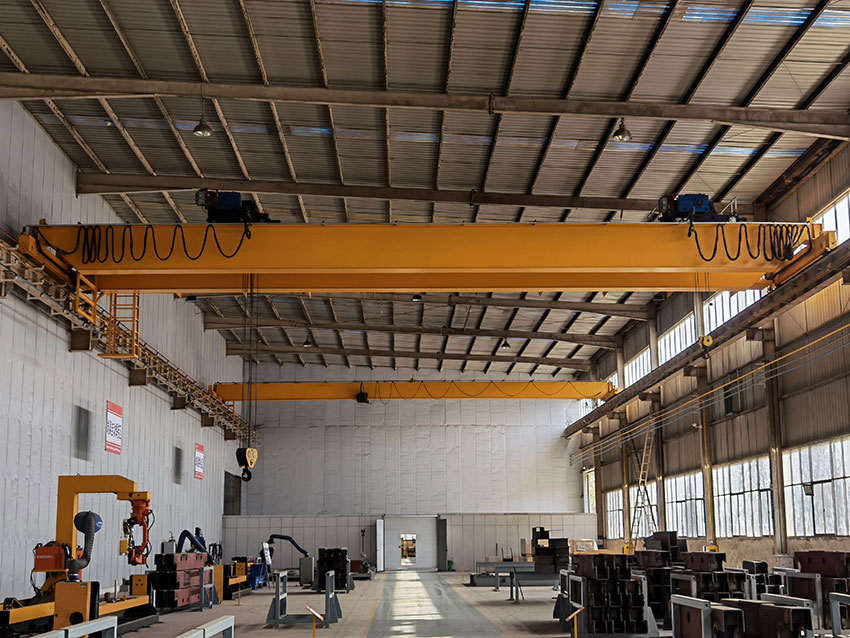Bridge cranes are essential equipment for industries requiring heavy lifting and material handling, such as manufacturing, construction, steel production, and logistics. One of the most critical factors influencing the cost of a bridge crane is its lifting capacity. From light-duty cranes designed for small loads to heavy-duty cranes capable of lifting hundreds of tons, capacity plays a pivotal role in determining the overall price of the equipment. This article explores the connection between crane capacity and cost, providing real-world examples and insights into how capacity impacts pricing.

Understanding Lifting Capacity
The lifting capacity of a bridge crane refers to the maximum weight it can safely lift and move. Capacities can range from as low as 1 ton for light-duty cranes to over 500 tons for heavy-duty industrial cranes. Higher capacities require more robust structural designs, stronger materials, and advanced engineering, all of which contribute to increased the bridge crane cost.
Factors Linking Capacity and Cost
1. Material Strength and Quantity
The higher the lifting capacity, the more robust and durable the crane’s components need to be. This includes the girders, hoists, trolleys, and end trucks. For example, a 100-ton double girder bridge crane requires thicker steel and stronger welds than a 10-ton single girder crane. These enhancements result in higher material costs.
Example: A 5-ton single girder bridge crane may use standard-grade steel with moderate thickness, costing around $20,000. In contrast, a 50 ton overhead crane price may be $150,000 or more since the crane requires high-strength steel and a more intricate design.
2. Structural Design and Engineering
As capacity increases, the complexity of the crane’s design also grows. Larger capacities demand precise engineering to ensure stability, safety, and efficiency under heavy loads. These cranes often feature advanced structural elements such as box girders or trussed designs, which increase production costs.
Example: A 20-ton bridge crane designed for indoor use in a warehouse might have a straightforward single-box girder design. On the other hand, a 200-ton crane for a steel mill might include dual box girders, reinforced supports, and additional safety systems, making it significantly more expensive to design and manufacture.

3. Hoisting and Control Mechanisms
Higher-capacity cranes require more powerful hoists and motors to handle heavy loads efficiently. These hoists often include advanced features like variable frequency drives (VFDs) and precise control systems to ensure smooth operation and safety.
Example: A 10 ton overhead crane cost might be $5,000 if it is equipped with a simple wire rope hoist. For a 100-ton crane, the hoist might include dual motors, larger wire ropes, and redundant braking systems, with costs exceeding $50,000.
4. Safety and Compliance
With greater capacity comes an increased need for safety features to protect workers and equipment. Heavy-duty cranes are often equipped with load monitoring systems, anti-sway mechanisms, and emergency stop functions. Compliance with industry standards such as ISO, FEM, and OSHA also adds to the cost.
Example: A light-duty 3-ton bridge crane might include basic safety features like overload protection. A 300-ton crane, however, could feature advanced load monitoring systems and real-time diagnostics, adding tens of thousands of dollars to its price.
Real-World Examples of Capacity-Driven Costs
Example 1: Small Manufacturing Facility
A small metal fabrication workshop requires a 5-ton single girder bridge crane to lift steel plates and components. The crane spans 15 meters and features a basic control system. The total cost is approximately $25,000, including installation.
Example 2: Precast Concrete Plant
A precast concrete plant needs a 50-ton double girder bridge crane to lift large concrete beams. This crane spans 30 meters and is equipped with a heavy-duty hoist, remote control operation, and anti-sway technology. The total cost is around $200,000, reflecting the increased capacity and advanced features.
Example 3: Steel Mill Application
A steel mill requires a 200-ton double girder bridge crane for handling molten metal ladles. This crane has a span of 40 meters, heat-resistant components, and redundant safety systems. The total double girder overhead crane price exceeds $1.5 million, driven by the extreme capacity requirements and specialized features.
Balancing Capacity with Cost-Effectiveness
When selecting a bridge crane, it’s essential to balance capacity with cost-effectiveness. Overestimating capacity can lead to unnecessary expenses, while underestimating it may result in operational inefficiencies and safety risks. Here are some tips to find the right balance:
- Analyze Operational Needs: Assess the maximum weight of the loads you’ll be lifting and choose a crane with a slightly higher capacity to accommodate future growth.
- Consider Usage Frequency: For infrequent heavy lifts, a lower-duty cycle crane may suffice. For continuous operation, invest in a higher-duty cycle model.
- Opt for Modular Designs: Modular cranes allow for capacity upgrades without replacing the entire system, offering long-term cost savings.
- Consult with Experts: Work with reputable crane manufacturers to determine the optimal capacity and features for your specific application.
Future-Proofing Your Investment
Investing in a bridge crane is a long-term decision. While higher-capacity cranes have higher upfront costs, they may offer better durability and versatility, reducing the need for future replacements or upgrades. Additionally, modern technologies such as IoT-enabled monitoring systems can improve efficiency and reduce maintenance costs over time.
Conclusion
The role of capacity in determining bridge crane costs is undeniable. From material requirements to engineering complexity, every aspect of a crane’s design is influenced by its lifting capacity. By understanding these cost drivers and considering real-world examples, businesses can make informed decisions when selecting a bridge crane. Whether you’re equipping a small workshop or a large industrial facility, carefully balancing capacity with operational needs will ensure a cost-effective and efficient solution for years to come.